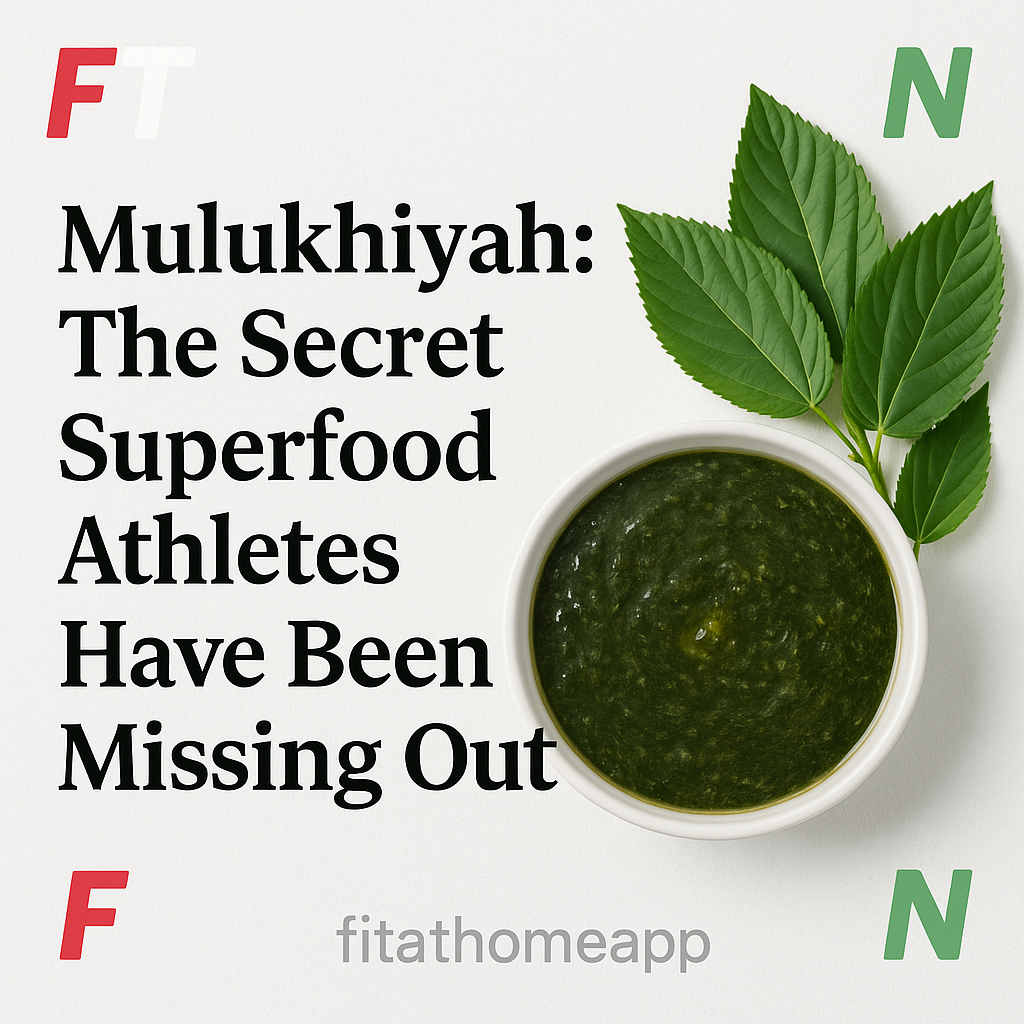✅ Introduction to Mulukhiyah and Its Benefits:
Mulukhiyah, also known as jute leaves, is a green leafy vegetable that has been a key part of Middle Eastern and North African dishes for centuries. It’s especially popular in places like Egypt, Lebanon, and Tunisia, often served as a warm stew or soup. Its slightly thick texture and mild flavor make it both unique and comforting.
While mulukhiyah is well-loved in traditional kitchens, it hasn’t gained much attention in the world of sports nutrition. That’s surprising, considering how packed it is with nutrients. It contains vitamins like A, C, and K, as well as minerals such as calcium and iron—important for energy, muscle health, and recovery.
For athletes looking for natural, wholesome foods to support their active lifestyle, mulukhiyah is definitely worth exploring.
✅ Nutritional Profile of Mulukhiyah
Mulukhiyah is a true powerhouse when it comes to nutrients. It’s rich in:
- Vitamin A – supports vision and boosts immunity.
- Vitamin C – helps the body repair tissues and fight off illness.
- Vitamin K – plays a key role in bone strength and healthy blood clotting.
In addition to vitamins, mulukhiyah also provides calcium, which is essential for strong bones and muscle movement, and iron, which helps carry oxygen throughout the body—a must for athletes who push their bodies to the limit.
It’s also high in fiber and antioxidants, which aid digestion and protect the body from damage caused by stress or intense exercise. Compared to other leafy greens, mulukhiyah holds its own and even outshines some better-known superfoods.
✅ Health Benefits for Athletes
Mulukhiyah has several benefits that can make a real difference for anyone who trains regularly or follows a fitness routine.
- Faster recovery: Thanks to its antioxidants and anti-inflammatory properties, mulukhiyah may help muscles heal faster after workouts.
- Less soreness: It can help reduce muscle aches, which means you might feel better after tough training sessions.
- Stronger bones and muscles: Its calcium and magnesium support bone health and help muscles work properly.
- Steady energy: The fiber helps keep blood sugar stable, giving you more consistent energy throughout the day.
Adding mulukhiyah to your meals regularly may support your overall health while helping you train harder and recover quicker.
“Mulukhiyah offers a range of health benefits that make it an excellent food choice for athletes. Its rich content of iron, magnesium, antioxidants, and anti-inflammatory compounds helps support energy levels, muscle recovery, and overall performance.”
✅ Incorporating Mulukhiyah into an Athlete’s Diet
You don’t have to eat traditional dishes to enjoy mulukhiyah. Here are a few easy ways to add it to your routine:
- Smoothies: Add a handful of blanched mulukhiyah leaves to a fruit smoothie for a healthy boost.
- Sautéed side: Lightly cook it with garlic and olive oil and serve with chicken or fish.
- Soups: Add it to broth with spices like cumin and coriander for a comforting post-workout meal.
- Meal prep bowls: Mix mulukhiyah with quinoa, beans, or lentils to make a plant-based protein bowl.
Its versatility means you can enjoy it in different forms without getting bored.
“Incorporating Mulukhiyah into an athlete’s diet can provide a natural boost in nutrients essential for endurance, strength, and recovery. Whether consumed as a soup, stew, or smoothie ingredient, Mulukhiyah is a versatile superfood that fits easily into various meal plans for active lifestyles.”
✅ Scientific Research and Evidence
Although mulukhiyah isn’t widely studied in sports science, some research highlights its health benefits:
- Its high iron content supports oxygen delivery to muscles during physical activity.
- Antioxidants in mulukhiyah may reduce inflammation and speed up recovery.
- Fiber helps maintain a healthy gut, which is crucial for absorbing nutrients and staying energized.
These benefits make it a solid choice for athletes looking to get more from their meals, even if it’s not yet a mainstream superfood.
“Recent scientific research has begun to uncover the powerful nutritional and therapeutic properties of Mulukhiyah. Studies highlight its antioxidant capacity, anti-inflammatory effects, and potential role in supporting cardiovascular and immune health—providing evidence-based support for its traditional use and growing popularity in modern diets.”
✅ Historical Significance of Mulukhiyah in Athletic Cultures
In ancient Egypt, mulukhiyah was a valued part of the diet, often associated with health and vitality. Some stories suggest that even royalty and warriors consumed it to stay strong and energized. Over time, it became a common dish in many homes, passed down through generations.
While people back then didn’t have today’s science, they clearly understood the power of nutritious foods. Mulukhiyah’s long-standing role in supporting strength and stamina shows how traditional diets often had built-in wisdom that still holds true today.
“Mulukhiyah has held a valued place in various cultures throughout history—not only as a culinary staple but also as a source of strength and vitality. In ancient civilizations, including Egypt and the Levant, it was often consumed by warriors and laborers for its nourishing and energy-boosting qualities, making it an early ‘performance food’ in traditional athletic cultures.”
✅ Potential Drawbacks and Considerations
While mulukhiyah has many benefits, there are a few things to keep in mind:
- Possible allergies: Although rare, some people may have mild reactions. Try small amounts first.
- Quality matters: Look for clean, organic sources if possible. This helps avoid pesticides and keeps nutrients intact.
- Cooking tips: Don’t overcook it—light sautéing or steaming helps keep the vitamins and minerals.
- Balance: Like with any food, moderation is key. Eating too much of anything, even healthy greens, can cause digestive issues.
- “While Mulukhiyah offers a wide range of health benefits, it’s important to consider potential drawbacks and dietary factors. These may include issues such as preparation methods, individual digestive sensitivity, or interactions with certain health conditions or medications.”
✅ Comparative Analysis with Other Superfoods
Let’s see how mulukhiyah stacks up against some popular superfoods:
- Vs. Kale: Kale is great, but mulukhiyah has more iron and can be easier on digestion.
- Vs. Quinoa: Quinoa is high in protein, but mulukhiyah adds more antioxidants and fewer calories.
- Vs. Acai berries: Acai is known for its antioxidants. Mulukhiyah has those too—plus fiber, vitamins, and minerals for overall health.
In short, mulukhiyah offers a well-rounded mix of benefits that makes it just as valuable—if not more so—than many of today’s trendy health foods.
✅ Conclusion: Embracing Mulukhiyah for Better Athletic Performance
For athletes, choosing the right foods can make a big difference in how they feel, train, and recover. Mulukhiyah brings together a mix of important nutrients, antioxidants, and anti-inflammatory properties that support physical performance and overall well-being.
It’s easy to prepare, works with many recipes, and has a long history of supporting strength and health. Whether you’re a beginner in fitness or a serious competitor, mulukhiyah is a smart, natural choice to fuel your body and help you reach your goals.
Personal Take on the Video
This video, “13 Amazing Health Benefits of Molokhia (Mulukhiyah)”, offers a clear, engaging overview of the nutrient-rich profile of mulukhiyah. It effectively highlights general health advantages such as improved circulation, enhanced immunity, better digestion, and support for sleep and heart health. These benefits align well with my article’s focus on athletic performance and recovery.
Nutrient-Rich Powerhouse: According to Stylecraze, mulukhiyah offers a low-calorie profile (about 10 kcal per 100 g) and is rich in fiber, iron, calcium, potassium, and vitamins A & C—boosting circulation, immunity, digestion, and heart health.
Antioxidant & Blood Support: Its high potassium supports vasodilation to reduce cardiovascular strain, and iron promotes red blood cell production for better oxygen delivery—key for athletes’ performance.
Sleep & Anti-Inflammatory Benefits: Molokhia contains magnesium and anti-inflammatory compounds that may help improve sleep quality and reduce recovery–impeding inflammation.
The Nutritional Connection Between Mulukhiyah and Lettuce: A Powerhouse of Leafy Greens
Mulukhiyah (also known as Jew’s mallow) and lettuce are two widely consumed leafy greens that have played important roles in various global cuisines. While they differ in texture, taste, and culinary use, both share a common ground in their classification as nutrient-dense, low-calorie vegetables that contribute significantly to a healthy diet. Their connection goes beyond just being green and leafy—they both offer essential vitamins, minerals, and phytochemicals that support overall wellness and disease prevention.
Mulukhiyah is particularly popular in Middle Eastern and North African countries. It is typically cooked into a thick, flavorful soup or stew and consumed with rice or bread. Rich in vitamins A, C, and E, as well as calcium, potassium, and magnesium, Mulukhiyah is known for its immune-boosting and anti-inflammatory properties. It also contains dietary fiber and antioxidants that support gut health and combat oxidative stress. Traditionally used for its healing properties, Mulukhiyah has earned a reputation as a superfood in many cultures.
On the other hand, lettuce is widely used in salads and sandwiches around the world. It comes in many varieties such as romaine, iceberg, and butterhead. Although it is often perceived as a “light” vegetable due to its high water content, lettuce still provides essential nutrients like folate, vitamin K, and small amounts of iron and fiber. Its refreshing crunch and versatility make it a staple in Western diets, particularly in weight-loss and heart-healthy meal plans.
Both Mulukhiyah and lettuce belong to the broader category of leafy green vegetables, which are recognized for their role in reducing the risk of chronic diseases such as heart disease, type 2 diabetes, and certain cancers. They are low in calories and fat while offering a high content of vitamins, minerals, and plant-based compounds. Their inclusion in daily meals is encouraged by dietitians and healthcare professionals worldwide.
Another important similarity lies in their accessibility and adaptability. Both vegetables can be grown in home gardens or small farms, making them valuable not only for nutrition but also for food security. Their quick growth cycle and minimal environmental impact contribute to sustainable agriculture practices.
In summary, while Mulukhiyah and lettuce may appear different on the surface, they are united in their classification as powerful leafy greens with impressive health benefits. Incorporating both into your diet can provide a diverse range of nutrients that support energy, immunity, digestion, and long-term health. Whether enjoyed fresh in a salad or warm in a traditional stew, these vegetables are excellent choices for anyone seeking a more nutritious and plant-based lifestyle

